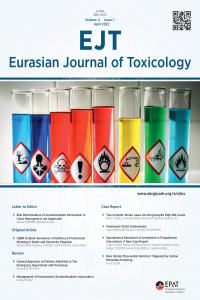Acute Myocardial Infarction Following 5-Fluorouracil Use
5-FU, göğüs ağrısı, MI
Acute Myocardial Infarction Following 5-Fluorouracil Use
5-FU, chest pain, infarction,
___
- 1.de Gramont Ad, Figer A, Seymour M, Homerin M, Hmissi A, Cassidy J, et al. Leucovorin and fluorouracil with or without oxaliplatin as first-line treatment in advanced colorectal cancer. J Clin Oncol 2000;18(16):2938–47.
- 2. Shimura T, Fuse N, Yoshino T, et al. Clinical features of interstitial lung disease induced by standard chemotherapy (FOLFOX or FOLFIRI) for colorectal cancer. Ann Oncol 2010;21:2005–10.
- 3. Alter P, Herzum M, Soufi M, Schaefer JR, Maisch B. Cardiotoxicity of 5-fluorouracil. Cardiovasc Hematol Agents Med Chem 2006;4: 1–5.
- 4. Fidan E, Fidan S, Yildiz B, et al. Bolus fluorouracil induced syncope and pulseless ventricular tachycardia: a case report. Hippokratia 2011;15:93–5.
- 5. Luwaert RJ, Descamps O, Majois F, Chaudron JM, Beauduin M. Coronary-artery spasm induced by 5-fluorouracil. Eur Heart J 1991;12:468–70.
- 6. Sorrentino MF, Kim J, Foderaro AE, Truesdell AG. 5-Fluorouracil induced cardiotoxicity: review of the literature. Cardiol J 2012;19: 453–8.
- 7. Sorrentino MF, Kim J, Foderaro AE, Truesdell AG, 5-fluorouracil induced cardiotoxicity: review of the li¬terature. Cardiol J 2012;19:453-458. http://dx.doi.org/10.5603/CJ.2012.0084
- 8. Alter P, Herzum M, Soufi M, Schaefer JR, Maisch B, Cardiotoxicity of 5-fluouracil. Cardiovasc Hematol Agents Med Chem 2006;4:1-5.
- 9. Wacker A, Lersch C, Scherpinski U et al. (2003) 5-fluorourasil ile tedavi edilen hastalarda yüksek angina pektoris insidansı: 102 hasta ile planlanan bir sürveyans araştırması. Onkoloji 65: 108-112CrossRef PubMed Google Akademik
- 10. Forni M de, Malet-Martino MC, Jaillais P ve ark. (1992) Yüksek dozlu sürekli fluorourasil infüzyonunun kardiyotoksisitesi: prospektif klinik bir çalışma. J Clin Oncol 10: 1795-1801Google Akademik
- 11. Kleiman NS, Lehane DE, Geyer CE, et al. Prinzmetal’s angına during 5-fluorouracil chemotherapy. Am J Med.1987;82:566-8.
- Yayın Aralığı: Yılda 3 Sayı
- Başlangıç: 2019
- Yayıncı: Acil Tıp Uzmanları Derneği
The Effects of Moon Phases on Suicide Attempts
Avni Uygar SEYHAN, Nihat Müjdat HÖKENEK, Nurhayat BAŞKAYA, Erdal YILMAZ, Semih KORKUT, Hatice Kübra ÖNDER KARAGÖZ, Huda ALMADHOUN
Evaluation of the Relationship of Serum Digoxin Levels with Demographic Data
Hatice Şeyma AKÇA, Abdullah ALGIN, Serdar ÖZDEMİR, Kamil KOKULU, İbrahim ALTUNOK
Ticagrelor Intoxication: Overdose in a Suicidal Attempt
Sertaç GÜLER, Dilber ÜÇÖZ KOCAŞABAN
Acute Myocardial Infarction Following 5-Fluorouracil Use
Şükrü GÜRBÜZ, Muhammed EKMEKYAPAR, Hakan OĞUZTÜRK, Neslihan YÜCEL, M. Gökhan TURTAY, Serdar DERYA
Plasma Lactate Levels in Carbon Monoxide Intoxication, Can be Used at First Step?
Sinem DOĞRUYOL, İlker AKBAŞ, Erdal TEKİN
Zehirlenmelerde Ekstrakorporeal Tedaviler
Serdar ÖZDEMİR, Kamil KOKULU, Abdullah ALGIN, Hatice Şeyma AKÇA
A Rare Cause of Serotonin Syndrome: Chronic Olanzapine Use
Seda DAĞAR, Emine EMEKTAR, Meral TANDOĞAN, Şeref Kerem ÇORBACIOĞLU, Hüseyin UZUNOSMANOĞLU, Yunsur ÇEVİK
